Website & blogs © Louis Kraft 2013-2020
Contact Kraft at writerkraft@gmail.com or comment at the end of the blogs
The lead-in is long. It is also important, as it introduces you
to why I am capable of writing a film list.
I discovered film early in life and loved it, to the point that I wanted to be an actor. I studied acting in junior high school, high school, college, and then years after in professional theater groups. I worked in the industry for fifteen years (theater, film, TV, commercials, and print).

This image of LK was taken at Tujunga House on 5jan2017. I’m listening to something that I didn’t buy into … The story of my life, … and maybe yours. (photo © Louis Kraft 2017)
… But it didn’t go in the direction I wanted it to go in and I walked away “cold turkey,” just like quitting smoking, … and I didn’t gain a pound.
- I study film (at least four times a week). What? Why? Simple, I can’t tell you how much I learn about a storyline, plotting, dialogue, character development, scope, and on and on.*
* A few years back I functioned as a consultant to a person who wanted to write a novel (and what I told him also applied to how I view film). I’m not going to share his writing problems, but they were large. I provided a detailed redline of his manuscript pages and each review included pages upon pages by me that told him what he had to do to improve his story and prose (and this included many face-to-face consultations). … I wasn’t seeing any improvement and asked him if he read a lot. “Yes!” “Fiction?” “Yes.” … “Here’s what you need to start doing,” I told him. “When you read a book, what do you like about it? This would include what excited you, what made you cry, what made you turn the page, and so on. What didn’t you like about the book? Did it bore you? How and why? Did you put the book down and never return to it?” Moving forward. … “Could you improve the book that you were reading? If yes, how? … These are notes that you need to take, and you need to study them, for they will give you an insight on how to write fiction.” … As I said, I study film and I study everything I read (and I do research each citation—you learn a lot about lies and fiction here). - Film has always been with me, and I have always studied it (and from many angles) … but there is one thing that I cannot accept and that is film or nonfiction or fiction rewriting history.*
* Proven facts: Ned Wynkoop did not participate in the 1864 massacre and butchery of Cheyenne and Arapaho men, women, and children in Colorado Territory; George Armstrong Custer did not survive the 1876 battle of the Little Bighorn in Montana Territory; and Errol Flynn did not spy for Nazi Germany.
A film must grab and hold my interest from beginning to end. And just as important I must care about at least one character.
What follows is totally personal.
I write for me
… and I always have. This blog is for me, and it isn’t unusual for everything I write is for me. … Books, talks, plays, articles, blogs. My friends, regardless of what you think of this lead-in, everything I write is because I care about the subject matter. My hope is that you have an interest in it and read some of my words. … If not, I have just struck out.
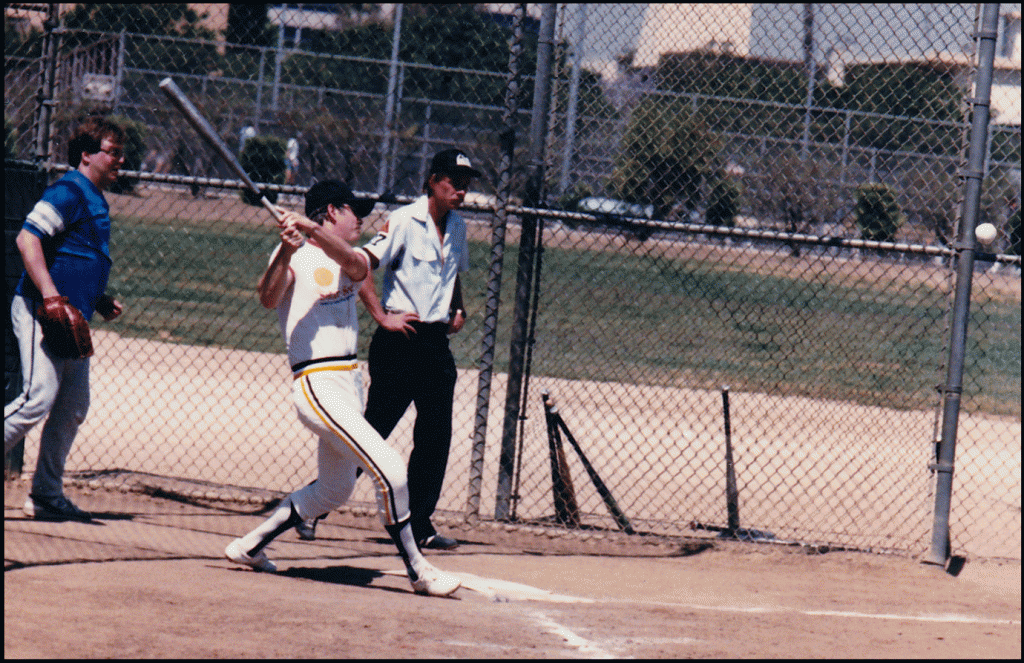
LK hitting a home run for the Warriors, a team I filled in for when they didn’t have enough players on any given game. I played third base for them, and in this image I slashed a hooking line drive to left-center field that resulted in a home run. My team was the Cool Aid Kids, and I played for them from spring 1980 until March 1990 (and our seasons were year-round). (photo © Louis Kraft 1989)
Baseball has always been a part of my life (but not so much during the last twenty-seven years). It was when I was a kid, it was when I was a young adult, and it again entered my life in1980 (after my mother’s death). … Sorry. I’m vague, way too vague. I know this as my friends ping me all the time.
Baseball. There’s one major thing about baseball, and I love it. If you don’t come to the plate and bat you can’t strike out, … if you don’t come to the plate and bat you can’t hit a home run. I love hitting home runs. … This ended forever on March 6, 1990, the day my brother died.
A film list?
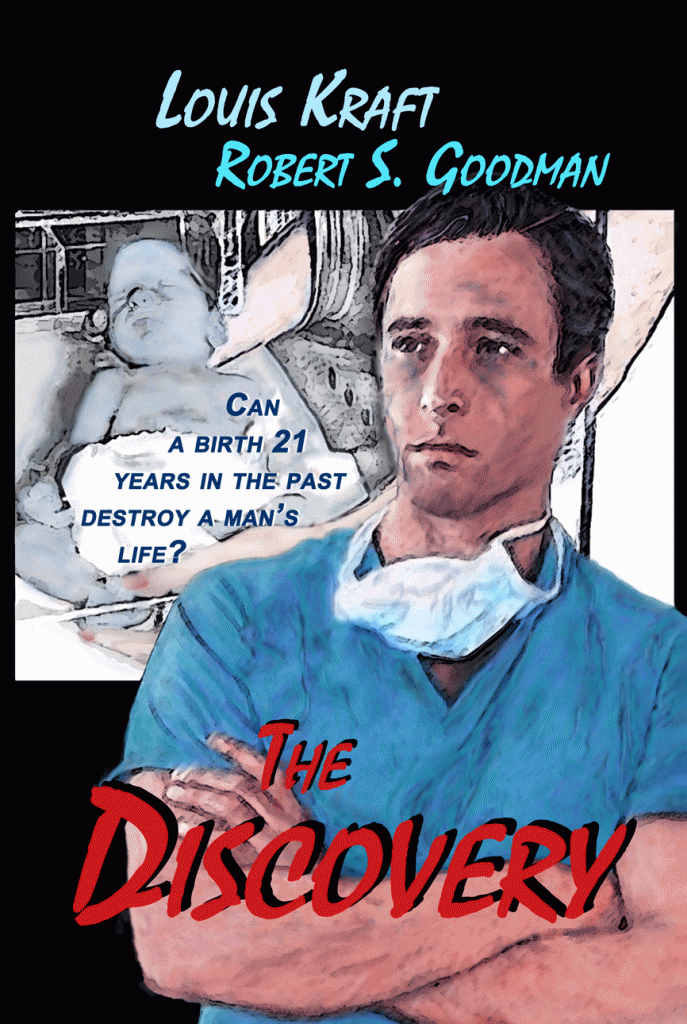
(art and cover design © Louis Kraft 2016)
I never wrote a list in my life until a few years back. A former friend insisted that I do a list of 10 Elvis Presley songs. I did this but then he got greedy and wanted Presley’s top 10 songs from the 1950s ’60s, and ’70s. At the moment I have 10 from the ’50s (but two are Christmas songs and one is religious), for the ’60s I currently have 40 songs (cutting this list down to 10 is a waste of my time for I’ll never be able to complete the hack job), but, alas, I only have one firm song from the ’70s. This shouts out loud and clear that Elvis’s creativity came to an end early in that decade. At least for me.
For the record, Elvis’s lone song from the ’70s* is heard while a yacht (the Newborn) is anchored off Santa Catalina Island (Los Angeles, California) in The Discovery. It is a medical thriller. The cover asks: “Can a birth 21 years in the past destroy a man’s life?” It can destroy a lot more than one life. The novel is a character study of people under extreme stress.** (Warning: It contains stark violence and is erotic.) I know, disgraceful, as I’m plugging one of my books … in a film-list blog.
* Burning Love (1972).
** One of the reasons I decided to partner on The Discovery was because I needed to play around with a number of leading and supporting players in a story that was a mixed-up mess over two decades. I’m a biographer, and Sand Creek and the Tragic End of a Lifeway is a much bigger mess to smoothly move between the historical people who drive the story to conclusion. I easily spend eight hours doing research to two hours writing nonfiction. Facts, facts, and more facts; mix them up with who is currently driving the story, and don’t fall on your face for believing errors (on purpose or not) in previously published works.
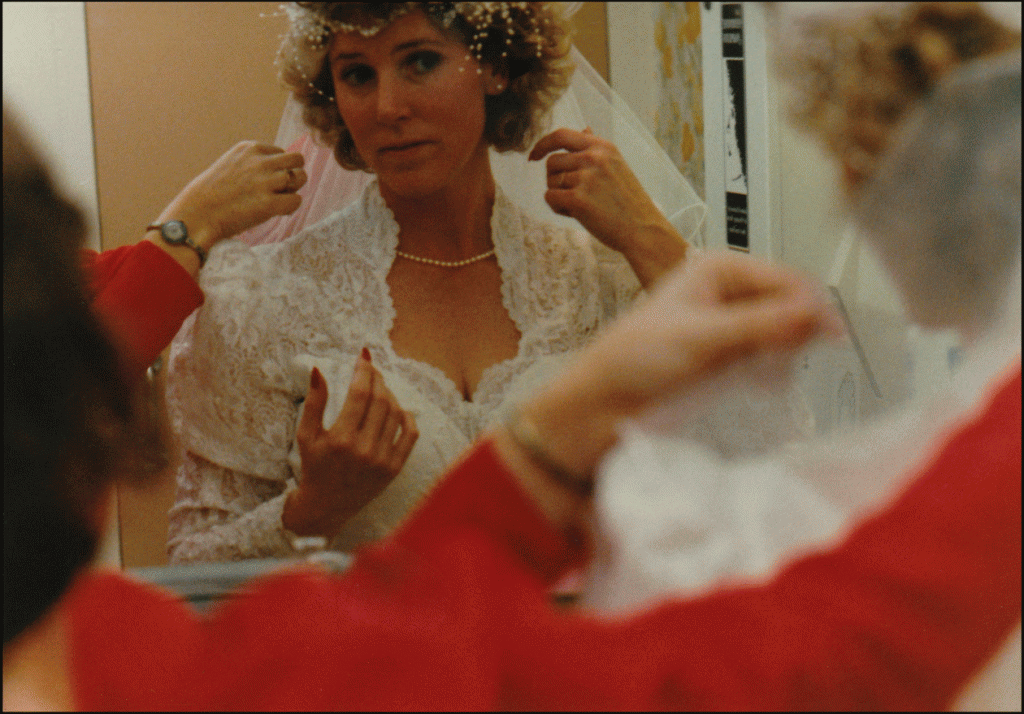
This is my sister, Linda Kraft, about an hour before she became Mrs. Greg Morgon in Long Beach, California, on 3dec1988. I took the wedding photos and had access to candids like this image. (photo © Louis Kraft 1988)
The following is for me and hopefully you
My sister Linda Kraft-Morgon (she was an LA County Sheriff and an investigator for the LA County District Attorney’s Office) had huge law enforcement connections with Germany, and she and her husband, Greg Morgon (he retired as a lieutenant from the LA County Sheriff’s Department) visited often and their German associates visited them in SoCal. … Will I ever travel to Germany? Doubtful. … There might be a research trip to England for the pirate Drake (which is almost spitting-distance close to Germany, and I love Eurorail), but if I don’t move to the southern coast of either Spain (research heaven!) or France a fair guess is that I will never return to Europe. … However, I did write an epic tragedy about Germany* (and, as almost always, my theme was racial and anti-war).
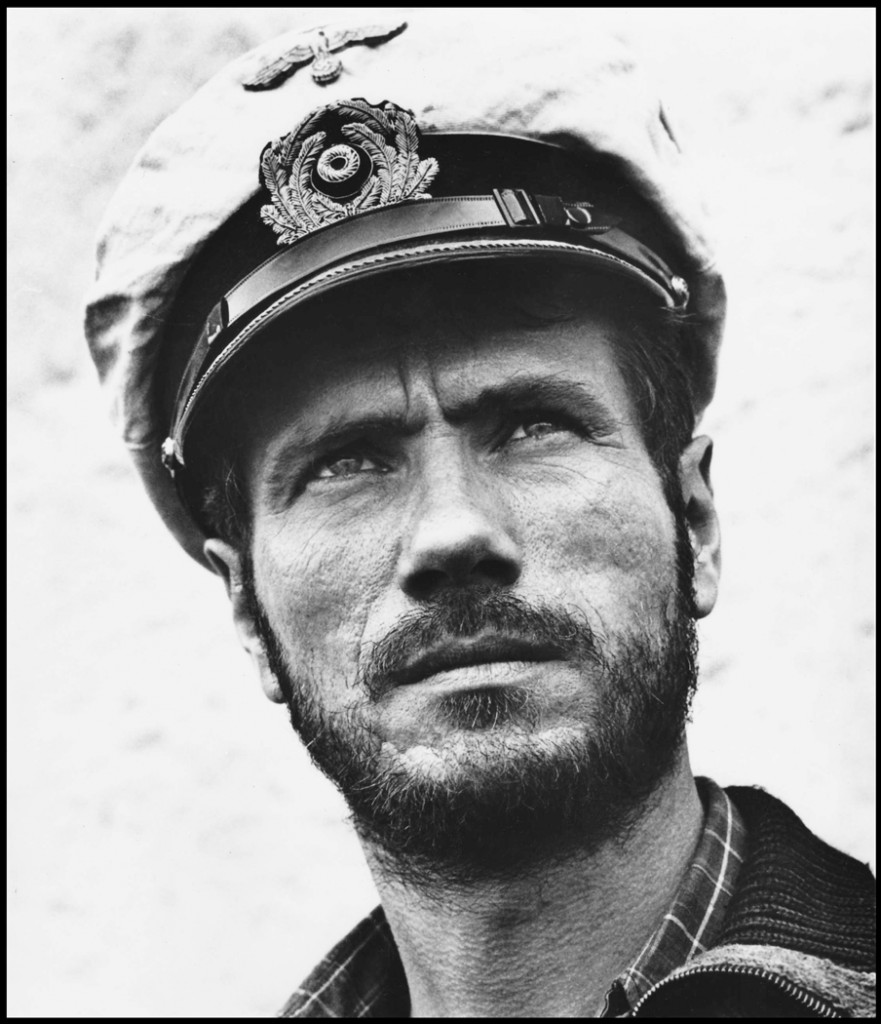
Jürgen Prochnow played the U-Boat commander in the great German anti-war film Das Boot (The Boat). In 1982 I played Miles Hendon in a 135-performance tour of The Prince and the Pauper in Northern California, and I choreographed the duel. When Das Boot opened in San Francisco I saw it without knowing anything about the plot. The film featured a lone U-Boat patrol. When the tour ended I fired Ed Menerth, my screenwriting agent. I had completed Wonder Boat in early 1981. He had told me, “I love it,” but he also told me that he couldn’t sell it as it was about racism, WWII, was a tragedy, and the hero was a U-Boat commander. … BTW, great performance by Prochnow. Oh, Das Boot will make my top 60 film list (which will be the topic for upcoming blogs). I’m struggling with how to create such a list because certain films, which perhaps should be included, won’t be on it. One is John Ford’s The Searchers (1956). Ford’s American Indians are mostly faceless “savages.” My view on this? You don’t want to hear it, and certainly not if you love Ford’s work. However, John Wayne’s racist performance in The Searchers is magnificent, and because of his performance, and only because of his performance, this film should be included in my upcoming list. Will it make the list? Doubtful.
* My best ever screenplay (agented, but not sold) dealt with the destruction of Germany during WWII as seen through the eyes of a U-Boat commander who wasn’t a Nazi (most U-Boat commanders refused to join the Nazi party but fought for their country with honor and with conscience). The title was Wonder Boat, and although the screenplay dealt with the various phases of the war and the U-Boat commander’s relationship with a Jewish woman (that’s right, a Jewish woman) the title referred to a U-Boat that was being developed, but the German high command’s hope that a fleet of these “boats” could prevent the inevitable never happened. The war ended before the first “Wonder Boat” launched for a combat mission. There is a copy of this script in the Louis Kraft Collection (Fray Angélico Chávez History Library, Santa Fe, New Mexico). … I still have all of my research. If finances go south, and I experience a forced exit from the USA, this story is a top contender to become a novel.
Let’s talk about something that means absolutely nothing
Huh? Sorry, but I’m back to the reason for writing this blog—film lists. … I know—who cares? Heck, I do and I hope that some of you do too.
I also know that some of you will not much care for the following list. … A few years back I had shared a 50 film list with someone who claimed to know film but admitted to me that he hadn’t seen most of the films on it. What goes around comes around as I hadn’t seen a lot of the films on his 50 film list. Love it, for it shows that even though we are talking about film … we’re also dealing with oranges and apples in what we had seen. If you haven’t viewed every film how can you make a top 50 or top 60 film list? (I can certainly do a list on Flynn as I have seen all of his films wherein he had leading roles except Murder at Monte Carlo (1935), a British film that was never released in the USA (and unfortunately may be a lost film); and Hello God (1951), an anti-war film, in which EF had the original negative destroyed as he thought that the subject matter, and perhaps the quality of the film, might hurt his career. I believe that the patched together film has screened in Europe (and supposedly a number of reels have been discovered and are being restored). My view: I certainly hope so.
The above makes it clear that opinions on any artistic creations (fiction, nonfiction, plays, films, TV, song and music, poetry, and art) can never be totally valid.
Top film lists and what they are
I’ve always been able to create a top 10 Errol Flynn film list (since my first Elvis list). It has made certain people grind their teeth and complain (to the point that I don’t think that they have any teeth left, … just the nubs). Actually there are always Flynn films that are on the cusp of my list and could bump a current film and make the list. For some time I have avoided this by creating a follow-up Flynn list that included films 11-20. This is ridiculous and I don’t like it. Thus, the following will only include one Flynn list—the top 13.*
* Upcoming blogs will focus on other film lists including a top 60 films without Flynn, and top 10 film lists of the following: 1) Drama, 2) Comedy, 3) Thrillers, 4) Action, 5) War, 6) Westerns, 7) Race, and 8) Swashbucklers. Dramas, Thrillers, Westerns, and films that deal with Race have plenty of contenders; the other categories are difficult to fill. Obviously sequels are coming.
Finally on to the main event, … Mr. Flynn.
Top 13 Errol Flynn films
The top six films are alphabetical and are not in order (for the record if I could only keep six Flynn films they would be Adventures of Don Juan, They Died with Their Boots On, The Sea Hawk, Gentleman Jim, Four’s a Crowd, and The Sun Also Rises).
- Adventures of Don Juan, director Vincent Sherman, and w/Viveca Lindfors, Robert Douglas, Alan Hale, Jerry Austin, Romney Brent, Ann Rutherford, Raymond Burr, and Douglas Kennedy (1948)
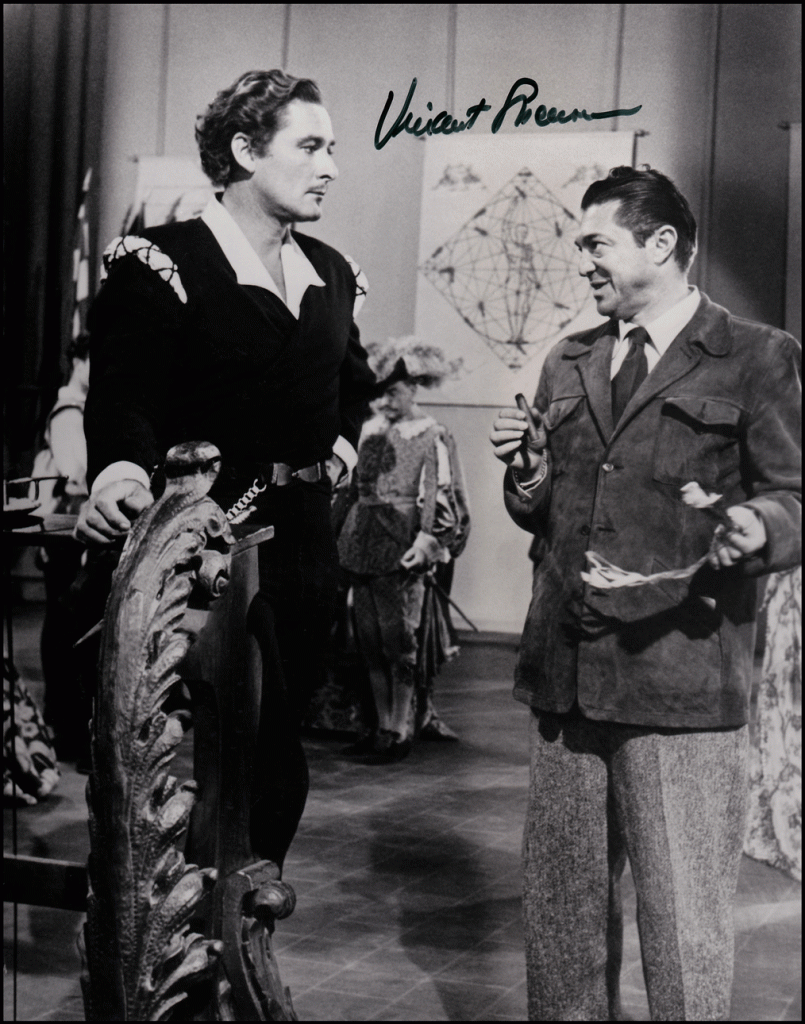
I think that it was Stan Maxwell, a good Flynn source and a better friend, who supplied Mr. Sherman’s address and phone number. This bit of information led to letters, phone calls, eventually a day meeting with Vincent wherein our conversation focused on Flynn and Don Juan. Afterwards, Vincent graciously answered follow-up questions that I had. All this information is locked away in a secure location, as are all of my other communications and transcriptions of interviews until I need them, including a couple of decades of contact with Olivia de Havilland (by the way, she is now Dame Olivia de Havilland). (photo in LK personal collection)
As Adventures of Don Juan is alphabetically first I need to say something immediately: Flynn’s Juan de Maraña, Gentleman Jim Corbett, Mike Campbell, and George Armstrong Custer are my favorite performances by him. Flynn had his own personal choices and one was Corbett (I will deal with them in upcoming books). In regards to Don Juan, Flynn liked and respected John Barrymore, the great stage actor who became a major silent film star. My grandfather (Eugene Small) saw Barrymore star in Dr. Jekyll and Mr. Hyde. I had been told that he was amazed with Barrymore’s transformation from good to evil on the New York stage. One problem here: I can’t find any proof that Barrymore played the dual roles on stage, even though everyone on my mother’s side claimed that my grandfather did. He did play Robert Louis Stevenson’s famed Dr. Jekyll and Mr. Hyde on film (1920), and my guess is that this is what he saw. Since my family is long gone (other than a cherished cousin that I haven’t seen in person since she was about eight years old), and she is wonderful but I’m a recluse or worse. My life revolves around Pailin and two others whom will remain unnamed. This is my life. Actually it was my father’s life during his last nine years after my brother’s death. There was a family across the street, along with three and a half people that were major to his life at that time (me, my brother’s best girlfriend of all time, the fellow who lived next door, and another person who can’t be named).
Oops! I’m supposed to be on Flynn’s Don Juan. Guess what? Mr. Flynn apparently liked Mr. Barrymore’s silent portrayal as Juan. This meant one thing, he wanted to follow in the “Great Profile’s” footsteps, as he counted himself lucky to know and befriend this great actor. Yes, Flynn, who often trashed himself playing heroes, wanted to play the great Don on film.
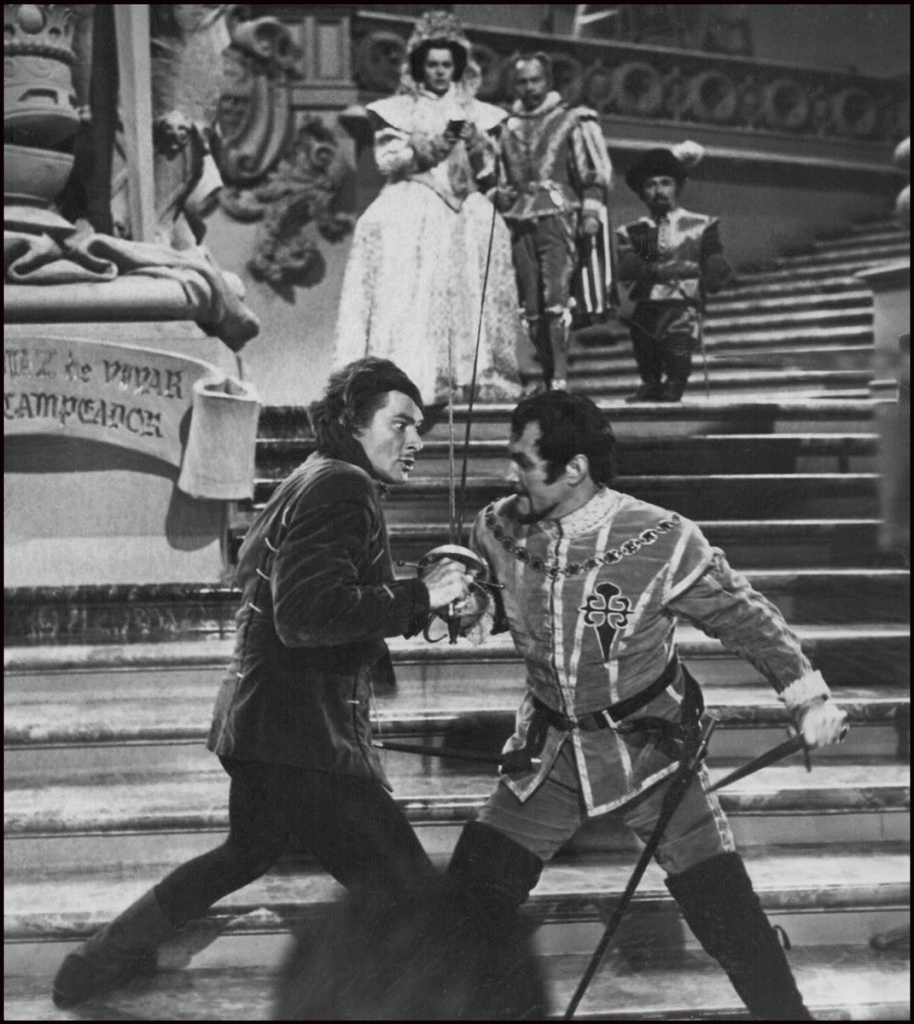
This is actually a tight shot of Flynn crossing blades and soon daggers with Douglas (who instantly became Flynn’s major swashbuckling nemesis even though he wasn’t very good swinging a rapier). This image, which is numbered, was taken by a staff photographer assigned to the film. … But what happened here? A good portion of the image is out of focus, there is a head in the foreground (an extra, someone watching the action?). This image—and with all its problems is magnificent even though Queen Margaret (Lindfors), King Philip III (Romney), and Don Sebastian (Austin) are out of focus—as it shows Flynn and Douglas in mortal combat. One will survive (and yes, the film is a tragedy). Douglas has yanked out his dagger and within seconds so will Flynn to parry the thrust. At this point in time the duel steps into another world of swashbuckling reality. (this torn, crinkled, and numbered image is in LK’s personal collection)
And did he! When filming began in October 1947 Flynn not only understood who he was, but also what the public expected of him on film. His performance as Juan is sad; it’s full of charm and charisma that only he could deliver; full of a life lost and yet not forgotten; it is also full of laughs that are based distinctly upon his screen persona (yes, Flynn had no problem laughing at himself). The film Adventures of Don Juan belongs to Flynn and to no one else. He was able to combine his screen presence with his ongoing life and come up with a middle zone that presented who he was on film and in real life. Flynn’s Don Juan is heroic while also being tragic. In my opinion this was Errol Flynn’s best performance on film. This includes every other film in this list, and a major reason why each of these movies made the list was because of Flynn’s performances in them.
It has been oft-stated that Flynn had to have short takes during the dueling scenes. If you have ever swung a blade and fought competition (and I have), let me tell you that you are feeling it after a 30-second exchange. Yes, Flynn’s smoking certainly impacted his stamina, but you know what? It is what is on film that counts—and all of Flynn’s dueling in Adventures of Don Juan is the best that I’ve seen on film. (The Sea Hawk’s final duel is second).
- Escape Me Never, directed by Peter Godfrey and w/Ida Lupino, Eleanor Parker, and Gig Young (1947).
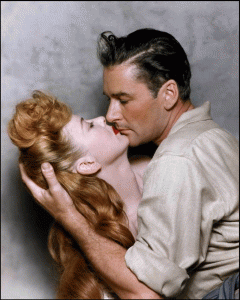 This publicity image of Flynn and Lupino was published as a full-page color image in a 1947 movie magazine. While in junior high school and waiting for my mother to pick me up after a fencing lesson with the great Ralph Faulkner I spent my time in a large used book store next to his studio on Hollywood Blvd. The bookstore (sorry, but it is long gone and I don’t remember the name) had shelves and shelves of movie magazines from the 1940s and 1950s. I sat on the floor and turned pages. Magazines that featured Flynn I bought (I had money as I worked). A few years later I met a girl one year younger than I (Judy Groh) at a friend’s party at his parents’ house. We hit it off and she became my first girlfriend. In those days everything in my life was innocent. Back to Flynn, … I showed her this image. She laughed and laughed and laughed. She pointed at Flynn’s hair and laughed some more. This image is simply WBs publicity—it is tender and yet has a hint of eroticism. I don’t know when the image was shot (I haven’t researched this film yet) but I think that the image was taken after Escape Me Never was filmed for Flynn didn’t look like this in the film (if I’m wrong, it was taken before filming began). (photo in LK’s personal collection, and it is not a scan of the 1947 magazine image, which I still have).
This publicity image of Flynn and Lupino was published as a full-page color image in a 1947 movie magazine. While in junior high school and waiting for my mother to pick me up after a fencing lesson with the great Ralph Faulkner I spent my time in a large used book store next to his studio on Hollywood Blvd. The bookstore (sorry, but it is long gone and I don’t remember the name) had shelves and shelves of movie magazines from the 1940s and 1950s. I sat on the floor and turned pages. Magazines that featured Flynn I bought (I had money as I worked). A few years later I met a girl one year younger than I (Judy Groh) at a friend’s party at his parents’ house. We hit it off and she became my first girlfriend. In those days everything in my life was innocent. Back to Flynn, … I showed her this image. She laughed and laughed and laughed. She pointed at Flynn’s hair and laughed some more. This image is simply WBs publicity—it is tender and yet has a hint of eroticism. I don’t know when the image was shot (I haven’t researched this film yet) but I think that the image was taken after Escape Me Never was filmed for Flynn didn’t look like this in the film (if I’m wrong, it was taken before filming began). (photo in LK’s personal collection, and it is not a scan of the 1947 magazine image, which I still have).
I hated this film, absolutely hated this film when young. The last time I had seen it was perhaps thirty years before it was finally released as a Warner Bros. Archive print-on-demand film. The production value, as critics complained, could have been better and it was just as I remembered. But when I saw it recently I was overwhelmed by the flow of the plot, and more important, Flynn’s subdued performance as a composer. Flynn was hurt and angered by the reviews of his novel, Showdown (1946), at the time he filmed Escape Me Never, and worse this film would be pounded by critics, and this affected him in more ways than one. I don’t blame him for he provided one of his better film performances as a man torn between two women, as a man who wants to do right but finds himself weak, as a man who finally realizes who he is and what is important to him. As for Showdown, I’ve read it at least six times and it has been a page-turner on each reading. … Flynn and Lupino were friends, although I’m not certain when their friendship began, and it registers in Escape Me Never. For the record, and this should be known, actors and actresses usually perform better together when they are friends and/or are in a relationship. I’m not implying anything here, for as far as I know Ida and EF were friends and I believe good friends (but that was all). Also for the record, a man and a woman can be friends, good friends, and it has nothing to do with sexual intimacy.

Sebastian Dubrok (Flynn) holds Picolo (as far as I know not credited; also, whenever possible producers try to hire twins) while a minister (Frank Reicher) marries him and Gemma Smith (Lupino). (photo in LK’s personal collection)
All of the above said, this film is about a woman (Lupino) who totally loves her man (Flynn). He loves her too, but his classical compositions have gone no where and his focus is on success and not his small family, which also includes her infant son, Picolo. They are poor and from the wrong side of the family. Without giving anything away, Flynn is a musical genius. Enter Parker, and she has what Lupino doesn’t have. He is also weak. More, and as you and I know, reaching for the stars is a difficult thing to do. You succeed or you fail. When you fail, that is you or I (and I only speak here from my point of view) the results can be disastrous. This was a view of life that Flynn wanted to explore, and in my opinion he succeeded here. This film holds my interest from the first reel until the end, and it moves me in ways that none of his other films have ever done. As an added bonus the great composer Erich Wolfgang Korngold, who scored seven of Flynn’s films (including 1935’s Captain Blood; 1938’s The Adventures of Robin Hood; my favorite, 1939’s The Private Lives of Elizabeth and Essex; and 1940’s The Sea Hawk), created this absolutely marvelous score, which also included an incomplete ballet (Primavera).
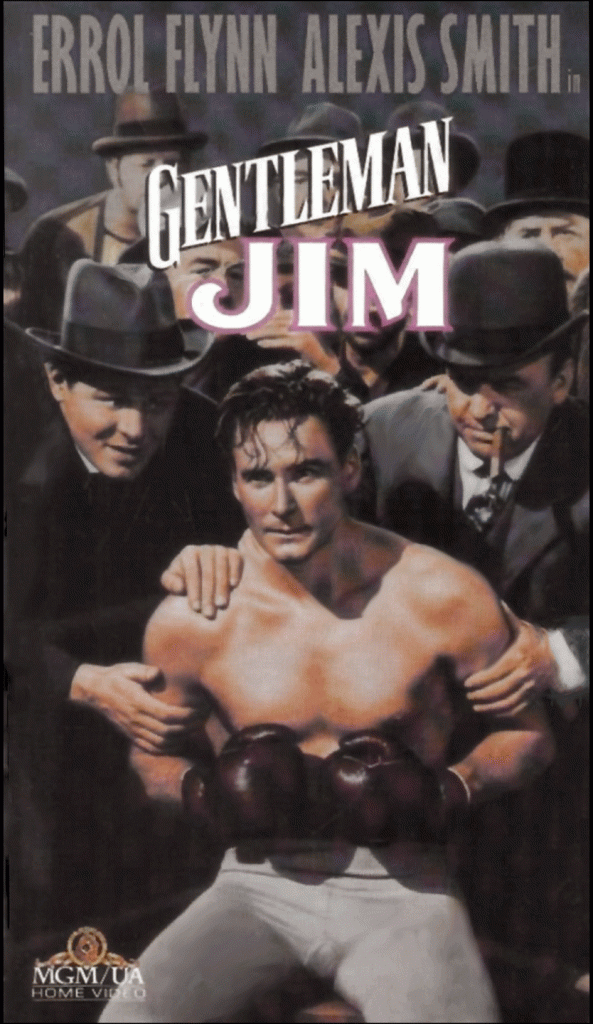
- Gentleman Jim, directed by Raoul Walsh and w/Alexis Smith, Jack Carson, Alan Hale, Ward Bond, and William Frawley (1942)
This is a video cover for Gentleman Jim. It is accurate, and is a pretty damn good representation of him in this this film. Warners, and not only for this film, but others, totally misrepresented what Flynn looked like in numerous films. This heinous stuff, and shame on Warners Bros., as Flynn didn’t have a mustache in this film even though their publicity sold him with a mustache (we’re talking major promotion here, including the 1942 USA one-sheet). Flynn wanted to play James J. Corbett, who would become the first heavy-weight boxing champion of the modern era. To this point in time boxing was flat-footed with charges at their opponents in the ring. Corbett would change that as he used his feet to avoid punches and counter-punched. The film is a light-hearted romp as Flynn’s cocky attitude upsets the rich as he strives to be accepted in society while rising in the boxing world (a lot of which was outlawed as the nineteenth century neared its end). The film is funny, fast paced and Flynn’s Gentleman Jim is a delight to watch. He trained with Mushy Callahan (a former welterweight champion) and was coached by sports writer and Corbett expert Ed Cochrane. Smith, a society woman, presented the perfect foil to Flynn’s attempts to climb in society. BTW Smith and Flynn were friends, and they make a dynamite combination in this film. Bond shined as heavyweight champ John L. Sullivan, who against betting odds, Corbett defeated at the climax of the film. Their scene together when Bond appears at Flynn’s celebration party is touching. Flynn, for the most part, was not doubled in the ring and the fight scenes really stand out. Luckily for Flynn Jack L. Warner was absent from the Warner Bros. lot during most of the filming and this allowed him to get away with murder while working on this film. Flynn constantly had his own idea of what lines were best for his characters, and often he changed lines during script development and during filming. When on set and shooting this is called “ad-libbing.” He was often called lazy for not learning his lines. Perhaps that happened at times, but not always and Flynn often had a hand in his dialogue. His reason for the changes was that he felt they improved his character. All of this will be documented in my books on Flynn. Flynn’s performance in this film was a revolution when viewing his acting capabilities, and better he pushes everything he knows about acting to the next level. … Jim Corbett is Flynn’s cockiest, assured, and most athletic persona on film. -

The 1940 1-sheet for The Sea Hawk (in LK personal collection)
The Sea Hawk, directed by Michael Curtiz and w/Brenda Marshall, Claude Rains, Flora Robson, Alan Hale, Henry Daniell, Una O’Connor, and Gilbert Roland (1940)
I’ve talked about The Sea Hawk for years, and I’ve made the comparisons to the pirate Drake’s life (see The pirate Francis Drake and Louis Kraft). I’m not going to repeat any of this here.
All I’m am going to say is that by 1939 Errol Flynn had discovered who he was as a film actor. From this time forward he had control over his performances, and many of them—not all, but most—dwarfed every film role he performed in 1938 or earlier except for The Dawn Patrol and Four’s a Crowd (below). This golden decade (actually eleven years) of Flynn’s acting (1939-1949) had a number of misses (that is average films for multiple reasons) but this eleven-year period contained most of his great acting performances (the only role beyond this timeframe was his portrayal as Mike Campbell in The Sun Also Rises, 1957). … I know, that for many this is pure heresy. It isn’t. If I extend this list to 15, you can bet that Captain Blood (1935) would make the cut (if for nothing else than the great slave auction at the beginning of the film), and of course The Adventures of Robin Hood (1938). But remember the key here is Flynn’s performances, the creative quality of the film, and not if the film was a mega hit, for this is something that I don’t care about.

This duel with Gilbert Roland ends peaceably at the beginning of the film when Flynn takes the Spanish vessel that transports Spanish ambassador Claude Raines to Elizabeth I’s English court. But later in the film, Roland would have the upper hand on Flynn. For the record, Roland would also have leading roles in film, including That Lady with OdeH (1955). In this first duel in The Sea Hawk Flynn displays how much his sword capabilities have advanced since The Adventures of Robin Hood (1938). (photo in LK personal collection)
We need to talk about Brenda Marshall here. She made one other film with Flynn, the decent comedy, Footsteps in the Dark (1941). She is okay in the comedy, and, (again more heresy), she is absolutely fine as the Spanish lady in waiting who views Flynn as a pirate. Their scene in an English rose garden after Flynn has received a verbal rebuff from Queen Elizabeth I in front of the court is simple and touching. Robson was light-years better than Bette Davis’s psychotic and almost spastic mess of a queen in 1939’s The Private Lives of Elizabeth and Essex. BTW, Flynn was fine in Elizabeth and Essex, and Olivia de Havilland absolutely shined as Lady Penelope Gray, a small role that was part of her punishment for daring to pursue being cast in Gone with the Wind (1939).

This scene was after Robson (Elizabeth I) verbally punished Flynn for attacking the King of Spain’s ship that transported his ambassador (Rains) and his niece (Marshall) to England. What Marshall doesn’t know here is that Flynn has since had a private interview with Robson and she has bought into his next piratical expedition to the New World. … It matters not, for this might be my favorite love scene of all time (and to this point in time Flynn is little more than a pirate that Marshall wants no contact with although she is happy that he wasn’t punished, that is sent to the Tower of London). Erich Wolfgang Korngold’s love theme for this scene is to die for; it is marvelous. (photo in LK personal collection)
By 1940 Flynn was no longer the novice star of Captain Blood or the blooming mega-star of The Adventures of Robin Hood (1938) but a full-blown leading man who defined what a swashbuckling leading actor could do in a major pirate film. The Sea Hawk is Flynn’s film from start to finish and he is in total control whenever he is on screen, and it matters not if he confronts Robson’s Elizabeth or Marshall’s lady who spurns his advances or the evil Daniel whom Flynn will eliminate in an extraordinary duel at the end of the film. Flynn’s Geoffrey Thorpe is magnificent from the first time you see him before he launches an attack on a Spanish galleon.
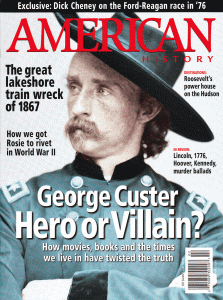 They Died With Their Boots On, directed by Raoul Walsh and w/Olivia de Havilland, Arthur Kennedy, Hattie McDaniel, Charley Grapewin, Sidney Greenstreet, Gene Lockhart, Stanley Ridges, and Anthony Quinn (1941).
They Died With Their Boots On, directed by Raoul Walsh and w/Olivia de Havilland, Arthur Kennedy, Hattie McDaniel, Charley Grapewin, Sidney Greenstreet, Gene Lockhart, Stanley Ridges, and Anthony Quinn (1941).
The February 2008 American History cover. I wrote the cover story for this issue, and at that point in time it was the magazine’s all-time best selling issue (don’t know if this is still true). As I have made clear over the years this film has had a major impact on my life. I’ve written four articles about the film and I’ve spoken about it in Texas, Missouri, Montana, and California twice (I need to add Oklahoma to the list, as I think that they may buy into the idea). The best article was a cover story for American History in 2008. For the record, this film is fiction and yet it is so close to reality at times that it is scary. Warner Bros. had a long track record for shying away from facts and real historical people for the simple truth that they feared being sued.The errors in the film are massive but when you look at how closely some of it is to reality while being disguised there is a lot that holds up nicely. However, when it came to the battle of the Little Bighorn the writers and Walsh chose to deal with mythic legend and an heroic end with Flynn holding his saber defiantly. The film end happens in a valley as Crazy Horse (Quinn) has set up a trap and attacks the soldiers. No, no, and more no. Custer divided his force into four independent commands and the battle began when Major Marcus Reno (he isn’t in the film; actually none of Custer’s Seventh U.S. Cavalry officers are in it) crossed the Little Bighorn River (also not in the film) and moved to attack the southern end of the massive village.
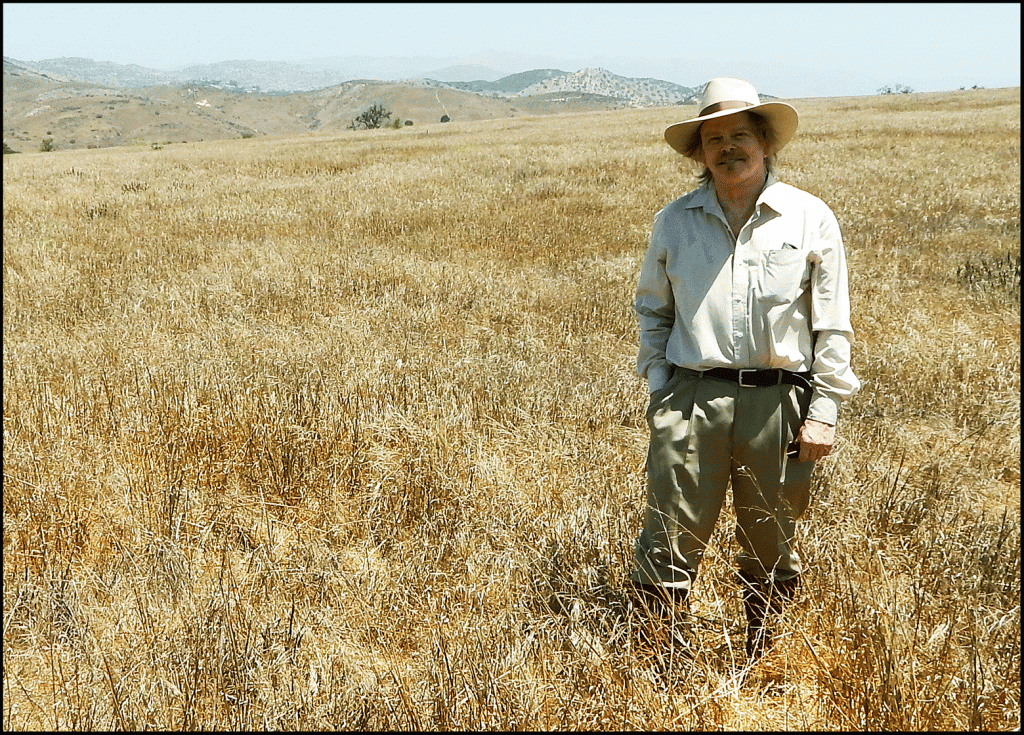
LK standing where Flynn-Custer’s small command marched to the Little Bighorn (13jul16). The east entrance to Lasky Mesa, a massive mountainous and valley area (in the Upper Las Virgenes Canyon Open Space Preserve), is on Victory Blvd. in Woodland Hills (a town in Los Angeles) in the San Fernando Valley. I’ve seen it printed that it is a seventy-mile drive from Universal Studios and worse that it took a day to get to the location from Warner Bros. (which is on the east side of the SFV). (photo © Louis Kraft 2016)
For the record I live three miles from Universal Studios and six miles from Warner Bros. I can make the drive to Lasky Mesa on surface streets in less than an hour. Even with dealing with some dirt roads in 1941 this would have been a fairly easy “drive to” from the studio on a daily basis that September. … There are places in Lasky Mesa where a river could have flowed and if WB wanted to film Custer’s end on terrain similar to where it happened in southeast Montana Territory it could have been done. But, … there’s always a but; the film was over budget. … This photo was shot almost a year ago when the temperature hovered around 100 degrees. On that day a person I knew showed me some locations for several great films. (photo © Louis Kraft 2016) … For the record, a lot of what has been published about this film in recent times is pure fantasy. Director Raoul Walsh, who directed Flynn for the first time in TDWTBO when EF made it clear to WBs that he would never again work with director Michael Curtiz, only to see their relationship end before the 1950s began. In my personal opinion the Walsh-directed Flynn films were much better than most of the Curtiz-directed Flynn films. … And better the Flynn persona would grow and change, and there would now be a dark side, but not yet.

A publicity shot of Olivia and Flynn as they travel to the American frontier. (photo in LK personal collection)
And the uniting of Flynn and de Havilland one last time—although neither of them knew this at the time—is a pure pleasure to watch as they work together and age in the film. They had been through a lot over the last six+ years both professionally and personally, and they certainly had their ups and downs in their relationship with each other. All this gave them a backstory that they could, and did, use as Mr. and Mrs. Custer. Their last scene in the film (but not the last scene they filmed together), was just before he marches toward the Little Bighorn River (again, there is no river in sight in the film) and destiny is so simple as she helps him prepare to go on campaign (a routine that they must have done every time he left on campaign) and yet is so poignant.*

LK with Olivia de Havilland at her home on 3jul2009; the third time that I was with her. (photo © Louis Kraft 2009)
* Max Steiner did the music for the film, mixing period music with his composition. However, the love theme that he created for George and Libbie (the correct spelling of Elizabeth Custer’s nickname) is mixed with bugle calls as the command prepares to march to Montana Territory and with Garry Owen (which was actually the theme song of the Seventh U.S. Cavalry as chosen by Custer) as they say goodbye and he exits to destiny. This is by far my favorite scene of Olivia and Flynn together.
I did open up a can or worms the first time I visited Livvie in her Paris home (2004). We talked a lot about this film and it being their last together (this was just something that happened as both were considered to costar in upcoming Warner Bros. films but it never happened as soon after she took the studio to court over her contract). At the beginning the TDWTBO conversation, she told me that “no,” she didn’t feel any different shooting this scene as opposed to others, but by the time it had gone deep into the night she came back to it for the third or fourth time. Surprisingly now it was suddenly different, for now she came up with a premonition … a premonition she now totally believes (and has since stated on camera).-
Uncertain Glory, directed by Raoul Walsh and w/Paul Lukas, Jean Sullivan, Lucile Watson, and Faye Emerson (1944)

Let’s begin by saying that Flynn’s portrayal as French criminal Jean Picard is one of my favorite performances by him of all time (and this has always been so). It’s restrained, and yet he allows the old Flynn persona to appear every now and again. The charm is present and so is the humor, and yet this film is a tragedy from the beginning. Worse, you care for the criminal Flynn from the get go and he is only alive as he has escaped the guillotine when German planes bombed France during WWII and destroyed the prison where he was about to be executed. He is a con-artist who’s only out for himself.
This Uncertain Glory (1944) video cover represents a tragic love story that should have had a happy ending. Jean Sullivan (above) delivered a very delicate and open performance. I found her different from most of the female leads in Flynn’s films, and honestly quite refreshing. Unfortunately she didn’t become a star, and I don’t know why. … Looking at this image, I have no clue if she had blue eyes (the film is in B&W). Looking at this same image I know damn well that Flynn’s eyes weren’t this color. … How many “artists” got this wrong? … I’d probably need a full page to document this error, which I’ve seen way-too-many times.
You know where the film is heading and yet you don’t want it to get there—at least I don’t. I want a happy ending as the story has redemption written all over it. … Actually it comes down to a question of how valuable is our life if we could trade it and save 100 innocent people from death. … What would I do? What would you do? What will Flynn’s character do? The film is a drama, and there is no action, and yet I’m on the edge of my seat every time that I watch this film.
The bottom seven films are in numerical order
—maybe & maybe not—I know that some people will consider me little more than an unfaithful cretin as major Flynn films, such as Captain Blood (1935), The Charge of the Light Brigade (1936), and The Adventures of Robin Hood (1938) didn’t make my list, and for multiple reasons. But again, I choose from a lot of criteria, and the following seven films meet my criteria. I’m not going to discuss why these three great films didn’t make my list (and all three are great), and that Flynn did with de Havilland, … and trust me that they will be discussed in Errol & Olivia. But if you’d like to know more (about two of these films that didn’t make the list), see Errol Flynn & Louis Kraft; the connection and a view.
Although I won’t discuss top film lists in Errol & Olivia, I will deal with all eight of their films in detail. What I say may surprise you and perhaps even shock you. … Hey folks, this is a comin’. Alas, Errol & Olivia will only deal with Olivia’s and Errol’s introduction to Hollywood, their life and times during their films together, and a very long epilogue. Trust me, for every hour it takes me to complete this manuscript will create a new understanding for you of these magnificent human beings who happened to be damned-good film actors. It will change a lot of what you currently thought you knew about them, correct egregious errors, and better it will be a book that I hope you read time and again. I know, the preceding statement is egotistical, but a writer must have an attitude when he dares to challenge fiction sold as nonfiction.
- Virginia City, directed by Michael Curtiz, and w/Miriam Hopkins, Randolph Scott, Alan Hale, Guinn (Big Boy) Williams, and Humphrey Bogart (1940)

Flynn with Miriam Hopkins. (photo in the LK personal collection)
Over and over and over again I have heard complaints why de Havilland didn’t play the lead role in this film. There are at least two reasons why, and one is that there is no way she could have danced in a saloon and made the audience buy it. Actually the anger is even larger, as de Havilland’s fans refused to accept Hopkins’ performance. Why? Some said, “Because she was older than Flynn.” Who cares! I don’t! Hopkins played a dance-hall siren who enticed every miner, drunk, and soldier in Virginia City, Nevada, which was a Southern stronghold during the American Civil War. … And best Flynn was infatuated with her singing and dancing too. This film required a raw sexuality that Hopkins provided, for if there was no Flynn-Hopkins draw to each other this film had no chance of working (and to place a target on my back, it would have had zero chance with de Havilland). At this late date I have one major regret here, and that is that Flynn and Miriam Hopkins didn’t work together again. (Those of you who hate this comment, sharpen your daggers and sabers but remember that I’m damned good with both.) I do know that by this time film audiences wanted Flynn’s costar to be de Havilland (but let me tell you that a lot more goes into this than meets the eye).
Virginia City has everything I want in a western, and this basically starts with that there aren’t any “bad guys” other than a supporting character played by Humphrey Bogart, who was still a few years shy of super-stardom. This film, this western, deals with the Civil War on the western frontier. … As I have always claimed in my nonfiction writing, “there are two sides to every story,” and it is certainly true in this film. Virginia City had a great cast, and that included Hopkins and Scott—two actors I wish that Flynn could have worked with again in the future. It was never to be. Our loss.
Can we call TDWTBO a western? I think so. If yes, what is Flynn’s second best western. The LK view: Virginia City with Dodge City a distant third.
- Objective Burma, directed by Raoul Walsh and w/Henry Hull, George Tobias, and William Prince (1945)

After the raid on the radar station Flynn split his command. They had a set meeting place. Flynn and those with have just reached this destination. (photo in LK personal collection)
More than any other film, this non-heroic picture gives us Flynn at war but not with his usual screen persona. He is reserved, and focused on completing a task: Parachuting into Japanese- controlled Burma during WWII and destroying a radar station. As Flynn and his men slowly inch toward their target the atmosphere is tense, and understandably so as everyone is aware that one mistake, just one slip-up, could mean disaster as there was no backup.

Detail of an image of Errol Flynn and Henry Hull during a lunch break during the filming of Objective Burma. Let me add something here, and it is totally opinion. When working on film I ate with people that I liked. I certainly can’t talk for anyone else, but this is what I did. (photo in LK personal collection)
The dense jungle that they cut their way through is alive with the sounds of nature, and it helps build tension. Some of Flynn’s command are typical cliché characters, but for me this was okay as you get to know them, their hopes, their desires. Without giving too much away, the film is just half over when the attack force reaches its target.
A reporter (Hull) accompanies the mission; older than everyone else he struggles to keep up, but his performance is decent as he vents his views on what he sees. More, it presents a Flynn who shows an emotion that I don’t think he ever shared in any of his other films (the closest might be The Sun Also Rises, 1957), and the sadness that affects him when he watches something happen rips my guts up every time I see the scene. I first saw this film on TV in the late 1960s or very early 1970s at my then-acting manager’s house in Hollywood. His name was Coy Bronson, and in the 1950s and early 1960s he worked with and knew some the then-film greats. I knew that he had worked with Montgomery Clift and I was interested to hear what he had to say. Nothing. He clammed up and said it was none of my business. If I dare to share what I saw and learned during my time with him in an upcoming memoir you will be shocked. On the night of my first viewing of Flynn’s Objective Burma we had gone out to dinner before watching the film in his living room as we sipped drinks. Bronson didn’t know Flynn but had a very negative attitude toward the film. My guess then (and now) was that he still had anger when his acting career didn’t take off. At this time he managed Samuel French’s Hollywood office (they were then leading play publisher in the USA; don’t know about now) and directed plays at the Pasadena Playhouse (Charley’s Aunt was one that I saw).
- The Dawn Patrol, directed by Edmund Goulding and w/Basil Rathbone, David Niven, Donald Crisp, and Melville Cooper (1938)

(1938 poster in LK personal collection)
Joanne Woodward, an Oscar winner, felt that Flynn’s performance as Captain Courtney was perhaps the closest he came to playing himself on film. I totally agree with her (see the best documentary that I’ve seen on Flynn’s life and film career for more of Joanne’s comments about him; The Adventures of Errol Flynn, 2005). I think that I should say that until modern times (and that is decades after Robert Redford’s poorly executed film The Great Waldo Pepper (1976), I haven’t liked any WWI arial films until I saw two modern films: Flyboys w/James Franco, Jennifer Decker, Jean Reno, and Martin Henderson (2006); and The Red Baron with w/Matthias Schweighofer and Lena Headey (2008, but not released in the USA until 2010). Flynn’s film is definitely dated, but this statement is totally based upon what could be created on film in 1938. … Do not doubt it, Flynn and Niven were close friends moving into the beginning of the 1940s, and this definitely gave both of their performances in Dawn Patrol extra spark and a relationship that was totally believable on film. I don’t know what happened between them, but something did for in the 1940s there is no mention of the end of their relationship, but it did end. Flynn and Niven are totally alive in all their scenes. More, they are rebels who don’t like being controlled by authority (Rathbone’s Major Brand). They are not James Dean (thank goodness!), but they are rebels and act and react to what is in their souls during this heinous time of WWI when human life didn’t mean much (hell, this is little more than a small piece of humankind and civilization). This is basically a character study of pilots in an extreme situation wherein they had a job to perform but with a life expectancy that wasn’t long. Flynn shines as Captain Courtney.
- Four’s a Crowd, directed by Michael Curtiz and w/Olivia de Havilland, Rosalind Russell, Patric Knowles, Walter Connolly, and Melville Cooper (1938)
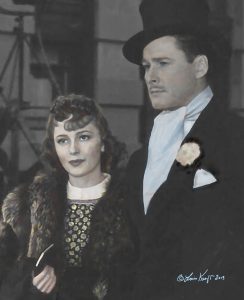
LK painting of Olivia and Errol talking with Four’s a Crowd director Michael Curtiz. (art © Louis Kraft 2013 & updated 2020)
This film will be featured in Errol & Olivia for their scenes together sparkle with fun and excitement, from the first time they meet at the Jamaica Room’s opening. Olivia is Lorri Dillingwell, and her grandfather John P. Dillingwell (a totally delightful Connolly) is a very rich man. Jean Christy (Russell) is an ace reporter at Patterson Buckley’s (Knowles in by far his best role in the three films he did with Flynn) failing newspaper. There’s one problem, Knowles intends to shut down the paper, which Russell doesn’t want to happen. She approaches Flynn’s Bob Lansford, who had been managing editor at Knowles’ paper until he was fired, but is now a hot shot public relations counselor. They decide to attend the club’s opening, but for different reasons. He wants to use Olivia to land Connolly as a client while Rosalind wants Knowles to reinstate Flynn as managing of the paper, as she thinks that he is the only person who can save it from crashing and burning. When Flynn and Russell join Olivia and Knowles at their table—something that Knowles does not want—Flynn turns on the charm and Olivia flirts with a bad-girl sexuality as she gobbles up his advances in ways that more than hint at what could be in their future. An outraged Knowles wants to derail what is happening before him but Olivia and Flynn refuse to allow him to interrupt. Four’s a Crowd is about who is going to end up with who, while Flynn pushes to land Connelly, whom he quickly turns into the most hated man in America with headlines in Knowles’ newspaper. Flynn and Olivia keep the sparks flying, which is a joy to watch until the end of the film when the couples get mixed up and we see who ends up with who.
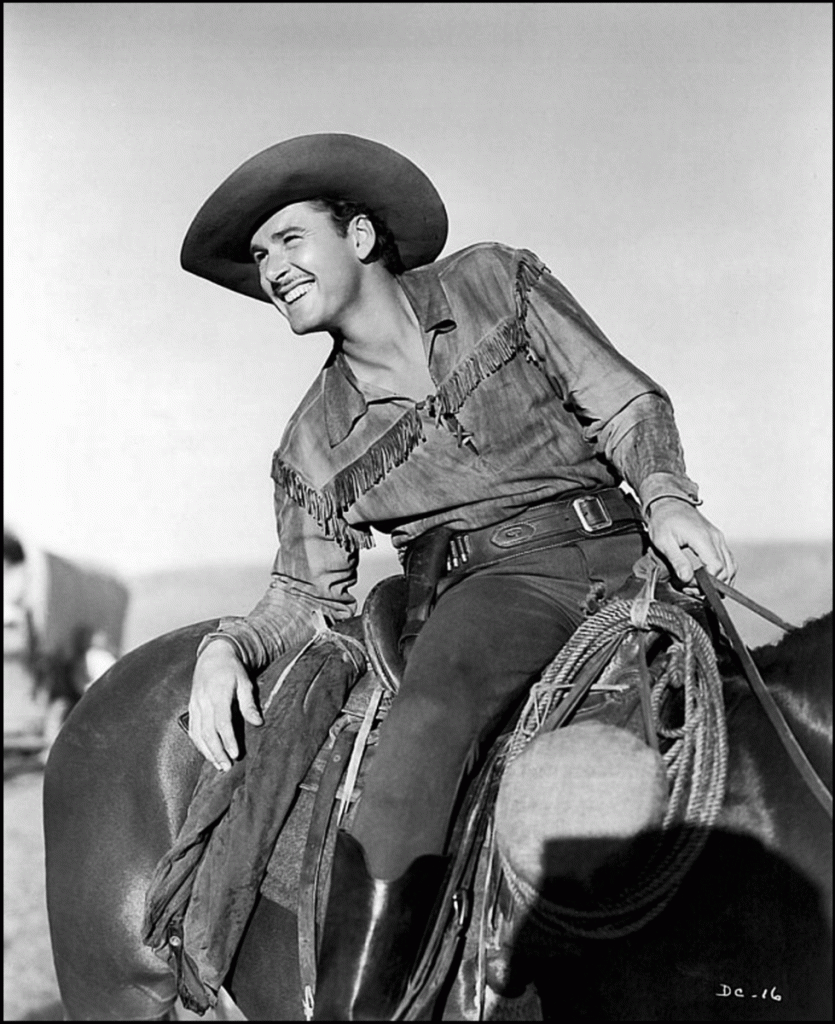
Flynn at the beginning of the film. (photo in LK personal collection)
- Dodge City, directed by Michael Curtiz, and w/Olivia de Havilland, Bruce Cabot, Allan Hale, Guinn (Big Boy) Williams, Frank McHugh, Victor Jory, and Ann Sheridan (1939)I’ve spent a lot of time with Dodge City elsewhere in these blogs, as I really like this film. What I like most—other than Flynn’s introduction to a genre that he felt totally miscast in—was Olivia de Havilland’s absolutely negative attitude that she brought to the film. She was angry, and rightfully so, for how Warner Bros. dissed her after her breakout performance in Gone with the Wind (1939), which included her first Oscar nomination. Better, she allowed her anger to direct her performance (and not her time on set, which happened during The Private Lives of Elizabeth and Essex).
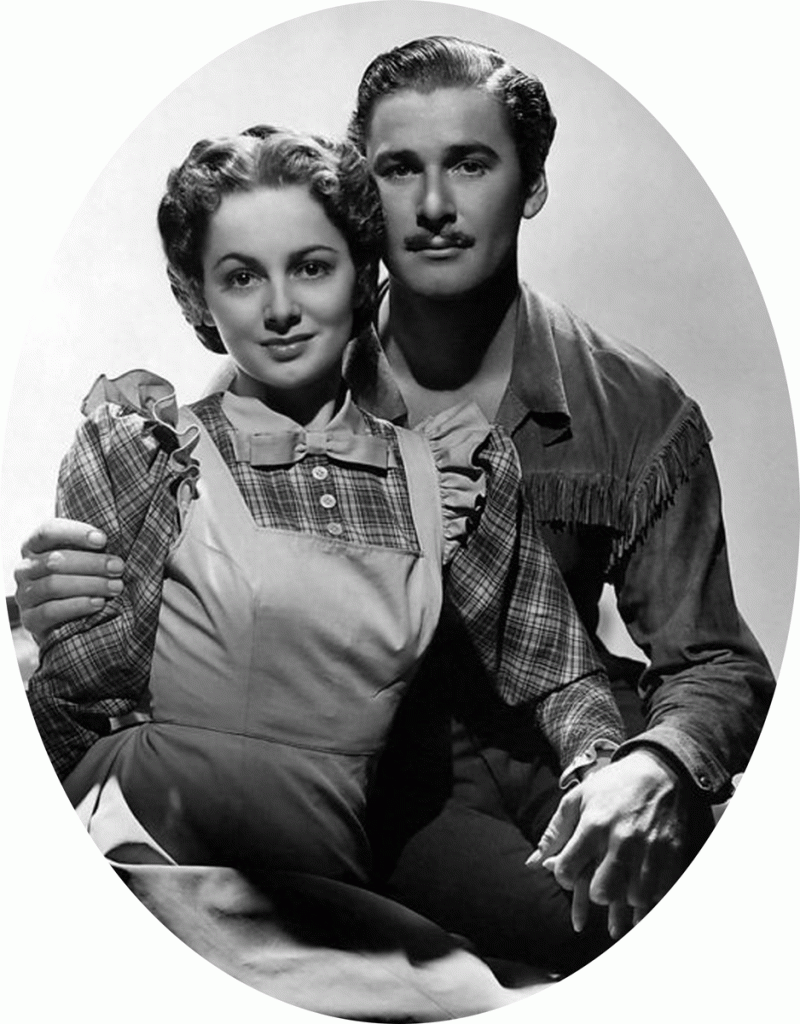
Publicity photo for Dodge City. (photo in LK personal collection)
My view: She was a total delight in Dodge City. Back to Flynn. He was clueless to who migrated to the American frontier in the 1860s. Clueless! Do you know how many Irishmen were on the American frontier? Flynn didn’t. The character he played was Irish. He wasn’t a lone Irishman; he was one of thousands. Oh yeah, and you can take this comment to the bank. Dodge City spreads over time and during it we see a life growth in Flynn’s character. Better, the film moves forward in a logical plot that must reach resolution. The film sparkles in each act except for the climax. Here, the villains are disposed of way-too-easily (and I’m being kind with this statement). These words led to a Virginia City–Dodge City flip while writing this blog (actually Virginia City was higher on the list and Dodge City dropped lower).
- That Forsyte Woman, directed by Compton Bennett and with Greer Garson, Walter Pidgeon, Robert Young, and Janet Leigh (1949)

Flynn getting rough with wife Greer Garson. (photo in LK personal collection)
To begin with this film bridges the gap between Gentleman Jim and The Sun Also Rises (see above and below) in multiple ways: 1) Period-piece plot construction, 2) Ensemble-cast performances, and 3) A real grasp of time and place. But it also had one additional element that was first displayed in Silver River with Ann Sheridan, 1948, and later in The Sun Also Rises, and that is a Flynn, totally foreign to what his fans expected of his films (there were other films at the end of his career that also provided this—most notably Too Much, Too Soon, 1957, when Flynn played John Barrymore. Like The Sun Also Rises, this film’s leading characters all work well with each other and their performances (along with a first-class supporting cast, read minor supporting players, all capture the culture and class-separation during the ending decades of the 19th century. This achievement was a combination of casting, directing, editing, and the result is extraordinary. The film is based upon John Galsworthy’s The Man of Property, the first of a trilogy of books that are now known as The Forsyte Saga. Flynn is this man of property and one of his treasured possessions is his-long pursued wife (Garson). What Flynn had created in Silver River he pushes to the next level. He’s ruthless, he’s jealous, he’s possessive, he’s in love, but he doesn’t know how to experience or show love, … much less make a relationship work. He’s clueless! But this is because he is a man of his times. Flynn’s performance is riveting, and so is Garson’s, Pidgeon’s, Young’s, and Leigh’s, and these five actors are first class in this film.
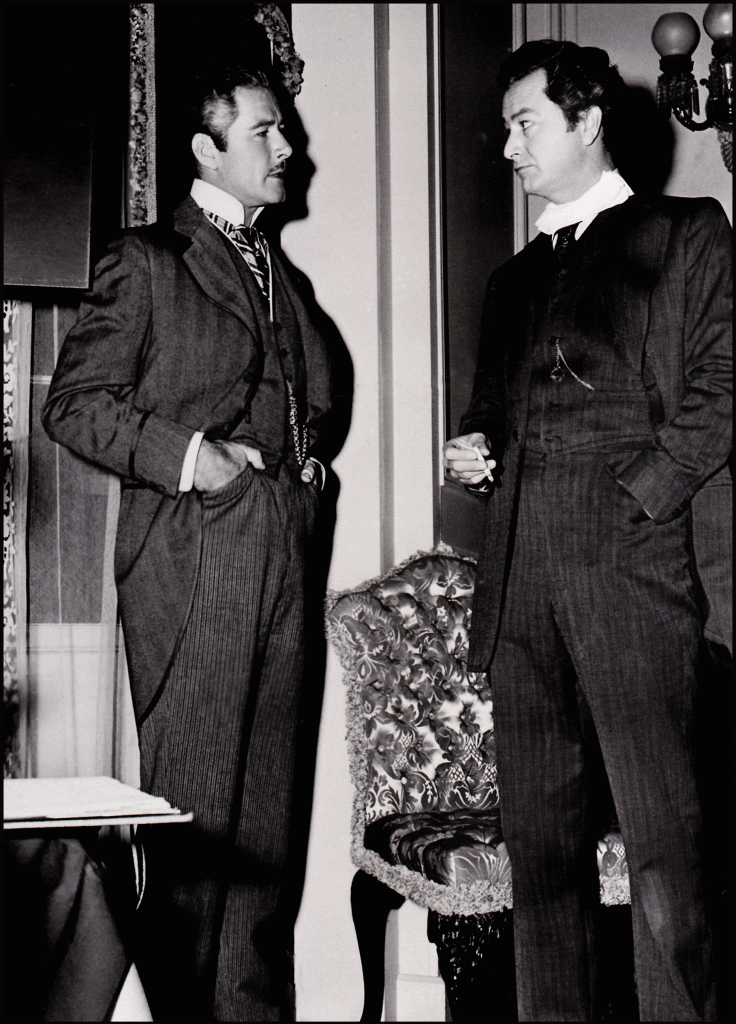
A candid of Flynn and Robert Young, who is absolutely marvelous in this film. (photo in LK personal collection)
As you can guess by now, That Forsyte Woman is a tragedy but I don’t want to share any of the details of the film for if you haven’t seen it you need to experience it first hand. Like many people who love Flynn’s film acting I didn’t much care for this film, actually early on I dismissed it. At this point in time someone should hit me in the head with a baseball bat for my prejudice against the film. All I can say is that I was an idiot when younger. Flynn’s performance is pristine! It was F—ing Oscar worthy. Shame on the Academy of Motion Pictures Arts and Sciences! This film, like The Sun Also Rises, is a mix and match of human beings at one point in time and place. They are who they are, and because of who they are, they react to situations predictably. Without giving away the plot I can’t expose what happens, but trust me for if you view this film with an open mind (in regards to Flynn) it is one that will grab your attention from beginning to end. Not many films do this for me.
- The Sun Also Rises, directed by Henry King and w/Tyrone Power, Ava Gardner, Mel Ferrer, Eddie Albert, Juliette Gréco, and Robert Evans (1957)

According to Patrice Wymore, Flynn’s third and final wife, she told him that he didn’t have to be drunk to play a drunk. She also hinted that he didn’t want to do the film as he would have fourth billing, but that she talked him into taking the part. For the record, this film is based upon Ernest Hemingway’s novel of a lost generation after WWI and it bores me to tears every time I read it. Reviews pinged the film as all the leading players were too old to play the roles. You know what? I don’t care. … Power, an actor who I usually find terribly leaden in his screen performances, plays a writer who is impotent due to wounds suffered during the war. But his life is about to change when Ferrer becomes an unwelcome visitor in his office. Power refuses to join him for a night in Paris, France, as he has a date with a woman that he doesn’t know. This is Gréco, who calls herself a working woman. BTW, Gréco’s part is small but it just oozes with sexuality during every minute she’s on screen. … The “date” moves from day into the Paris nightlife. Power is thrown for a loop when he stumbles upon Ferrer (good stuff as Gréco turns an introduction into chaos), but it gets worse when he sees Gardner (who he has had a past life with), and even though it has no where to go she can’t take her eyes off him.
This is a detail from a scene that Eddie Albert is also in. Flynn (left) is getting his shoes shined (something he does more than once in the film. He is with Gardner and Power. (photo in LK personal collection)
Power is sick of the entire situation, but has an out for his friend (Albert) and he have plans to travel to Pamplona, Spain, to see the bullfights.This is just the beginning of a character study of four men and Gardner, who is a flittering bird that can’t control herself while still caring for Power. Surprise of surprises—Ferrer told Gardner of Power’s destination, and she, Ferrer (who has already lost Gardner’s affections) and her broke, drunk, and on again and off again “fiancé” whom she’ll never marry (Flynn) are already Pamplona. This is an ensemble cast that works well together. They are at all times full of life, regardless if they are pleased or angry or experiencing the world of bullfighting in Henry King’s gorgeous-looking film.*
* For the record, when in elementary school, I saw this film as a second part of a double bill; I didn’t know who the heck Flynn was at that time but loved his performance.
In February 2000 Ferrer kindly answered some of my questions about Flynn when they worked together. Don’t think I’ll share any of them here, other than to say that everything he said about Flynn during the filming of The Sun Also Rises was positive. They will eventually see print in an upcoming book.

This photo is from a scene near the end of the film. From left: Mel Ferrer, Errol Flynn, Ava Gardner, and Eddie Albert. (photo in LK personal collection)
The running of the bulls is delightful fun when Flynn and Albert get caught in it. Their rapport on film is a standout in The Sun Also Rises. But the problems in place since the beginning of the film grow in Pamplona, and Flynn, who is love with Gardner but sick of Ferrer hanging around, and finally of an-up-and-coming bullfighter (Evans) who Gardner chooses for her next lover. … Although the focus is on Flynn films, I want to say that this cast worked well together and had well-defined characters without nary an unbelievable moment (the only exception being Evans, but he is okay).
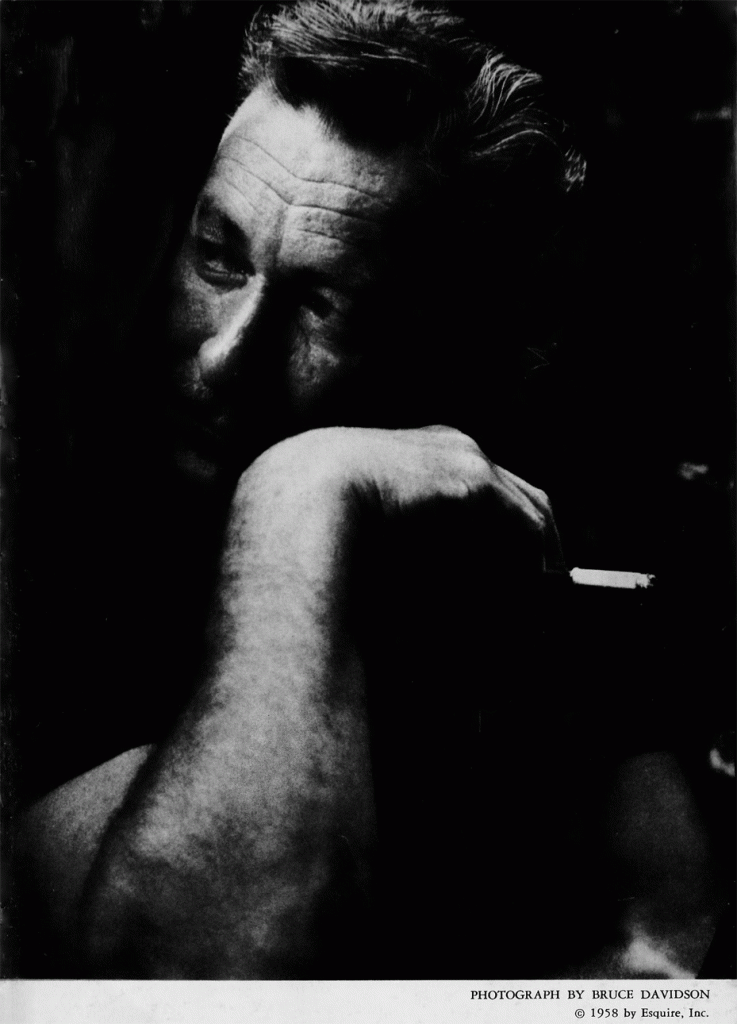
Flynn photographed by Bruce Davidson as used on the rear dust jacket cover for the first edition of Flynn’s My Wicked, Wicked Ways (image © Esquire, Inc. 1958)
Flynn gave a magnificent performance and I don’t give a hoot if he was drunk or sober when he was on camera. He was charming, funny, drunk, sarcastic, hurt, and at the same time his performance was terribly touching. There is a scene near the end of the film between Flynn (sitting on a bed) and Power (standing). They are basically saying goodbye (even though there are a couple of more scenes of them together), but there is much more here for when Power exits the room and the camera holds on Flynn we see a man who has lived life but has nothing. This reminds me of the great image of Flynn on the first edition of his memoir (My Wicked, Wicked Ways, 1959). Is Flynn an image for all of us as our lives near conclusion? At times I think yes (at least for me*). … In my opinion this was by far his best performance during the decade of the 1950s.
* For those of you who think I have a negative attitude on life I want to share the following. … On May 31 I told my pulmonary specialist that I planned to live to 130. He chuckled and said that he did too.
Finally …
Errol Flynn was a great film actor. He was natural at a time of over-acting. More, he was a human who could easily fit into our modern world of a mix of colors and race, for one simple reason—he wasn’t racially prejudiced and accepted people of all races as equal (and I can prove this).
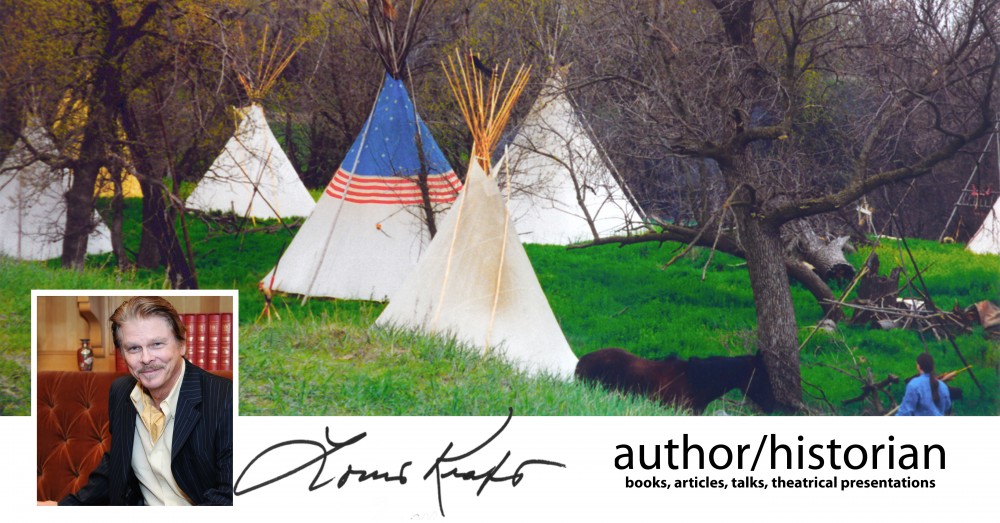
Louis –Just read your piece (apparently quite a bit after it was written) and felt I should thank you for cramming so many more smart and heartfelt observations about Flynn (and the moments that shined brightest in his films) into so few paragraphs—- the rest of his biographers do considerably less in 300 plus page books. In fact, I would go so far as to say that of all the millions of words that have been written about Errol, I think he would have enjoyed and appreciated the ones written by you the most.
Michael, I’m sorry it has taken me so long to post your thoughts on what I wrote about Errol Flynn in this blog for I really appreciate them. Actually, your words humbled me for I never thought what I knew or presented were in a world apart from other writers that attempt to document Mr. Flynn’s life and career. More, I wanted to comment on them but didn’t as I have a book coming out in spring 2020 (Sand Creek and the Tragic End of a Life) and everything is now moving at lightning speed. Plus I wanted to get a blog out (1st fifth of a Louis Kraft 50-film list), which in the last section, “What’s next,” announces that my next nonfiction book will be Errol & Olivia. The book will deal with Errol Flynn and Olivia de Havilland’s arrival in Hollywood, their being cast in Captain Blood, their life and times during the eight films they made together between 1935-1941, and an epilogue. Simply stated I have a lot of primary source material that will present this time period in their lives in a new perspective, and I won’t be shy in regards to exposing errors that are propagated time and again or false history created to sell books (and I’m being kind here). Some so-called historians use quotations that are little more than fabrications while citing obscure books and articles, I suppose figuring that none of their readers have what they cite or, if they do, won’t bother to check the accuracy. There will be two additional books on Mr. Flynn, and the research is ongoing. Moving forward, Errol Flynn is about to become my major-writing subject. Again, thank you for your kind words.
Thanks so much for taking time out to reply, Louis. Yeah, your upcoming book on Errol and Olivia is needed as a rebuttal to those who seem to write about the famous couple only for the sake of denigrating the truth. Not only do you come armed with plenty of research but you have what my writing teachers used to refer to as ‘intellectual sympathy’ for the subject. You can’t buy that at Macy’s. I look forward to what you produce (I know you won’t “be shy” about exposing the many lies that have been told about Errol).
Michael, thank you for your positive response. I saw it while on a work and R&R trip with my daughter. Although the trip was geared toward again writing articles and giving talks as well as selling a novel I couldn’t avoid Mr. Flynn and Ms. de Havilland as I was often asked, “What is next after your Sand Creek book is published?” By “next,” I’m talking about my next major book project. My last blog details my current status on Sand Creek and the Tragic End of a Lifeway as well as the rest of my proposed book-writing life. I do believe some of the information in Louis Kraft updates: Sand Creek Massacre, Errol Flynn-Olivia de Havilland, & Navajo Blood will be of interest to you.
Hi Louis,
I totally agree with the list and particularly your (re)assessment of Escape Me Never.
I really think Errol’s career from 1946-1953 is interesting. Unusual roles (EmN; Cry Wolf; Silver River, That Forsyte Woman, even Don Juan, which is not a typical swashbuckler – after all EF’s chief romantic interest is the (married) Queen of Spain!!).
Perhaps, considering the dark/unsympathetic tone of some of these roles, it is not all that surprising that none of the films from 1946-49 were overly successful in the US market. I think all fell below expectations in terms of domestic gross.
Not surprisingly EF bounced back a bit in 1950, with 3 successful movies (Montana; Rocky Mountain & Kim – which was a huge hit)
Anyway, I think this part of his career really needs reappraisal
Thanks
RJ
Hello RJ,
First, thank you for your well-thought comments on Flynn’s films between 1946 and 1953. My apology for taking so long to post your comments and my reply.
While a 2021 was a rough year across the world I experienced one of the best years of my life. Most likely much of what follows may not interest you. If not scroll to the end of my comments, for I’m certain that they will be of interest to you.
My last book, SAND CREEK AND THE TRAGIC END OF A LIFEWAY (University of Oklahoma Press, 2020) won two best nonfiction book awards in 2021, from the Colorado Author’s League and the National Cowboy & Western Heritage Museum’s Wrangler Award (my second; the first was in 2012). The Western Heritage Wrangler is major and is a 20lb bronze of a cowboy on a horse. When I get the chance I’ll post some photo on my website page for the book. But my year didn’t end there. The second Louis Kraft Collection was created at the University of New Mexico’s Center for Southwest Research & Special Collections. I made the first delivery in June 2021 and the UNM director for the Center picked up my second delivery in December 2021.
This Louis Kraft Collection is important as it also documents my life, but also because it is now contain that largest collection of Errol Flynn and Olivia de Havilland in the USA (and it will grow in the future). It contains 20 years of letter communication with Olivia, two visits to Paris to spend time with her and interview her plus 15jun2006, when she was honored by the Academy of Motion Picture Arts and Sciences (Beverly Hills, Ca.). It also contains over 2,000 pages of my double-spaced notes taken at the USC Warner Bros. Archives (Los Angeles, Ca.). I have probably close to three times that amount of documentation from the archives that are requested photocopies or PDF files, but can’t share them as they belong to the USC Warner Bros. Archives. I also have much more primary source documentation on EF and OdeH in-house.
My next nonfiction book will be ERROL & OLIVIA (it currently has about 75,000 words with some polished and some not. I’m writing this book just like my Indian wars nonfiction books. Also, I’m not finished with Mr. Flynn once E&O is published, for my follow-up nonfiction book will be ERROL FLYNN: THE DEFINING DECADE. Alas, it won’t cover all you desire to be explored, but it will be a major book for me. Unfortunately all the Flynn and de Havilland at the UNM LK Collection are on total lock down until both books are published or December 31, 2031, or whichever comes first (although I may release some material after ERROL & OLIVIA is published). This has been a long-time coming. No more detours.